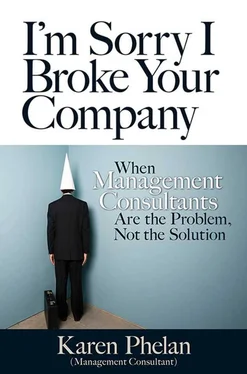Karen Phelan - I'm Sorry I broke Your Company
Здесь есть возможность читать онлайн «Karen Phelan - I'm Sorry I broke Your Company» весь текст электронной книги совершенно бесплатно (целиком полную версию без сокращений). В некоторых случаях можно слушать аудио, скачать через торрент в формате fb2 и присутствует краткое содержание. Город: San Francisco, Год выпуска: 2013, ISBN: 2013, Издательство: Berrett-Koehler Publishers, Жанр: management, popular_business, на английском языке. Описание произведения, (предисловие) а так же отзывы посетителей доступны на портале библиотеки ЛибКат.
- Название:I'm Sorry I broke Your Company
- Автор:
- Издательство:Berrett-Koehler Publishers
- Жанр:
- Год:2013
- Город:San Francisco
- ISBN:978-1-60994-740-8; 978-1-60994-741-5
- Рейтинг книги:3 / 5. Голосов: 1
-
Избранное:Добавить в избранное
- Отзывы:
-
Ваша оценка:
- 60
- 1
- 2
- 3
- 4
- 5
I'm Sorry I broke Your Company: краткое содержание, описание и аннотация
Предлагаем к чтению аннотацию, описание, краткое содержание или предисловие (зависит от того, что написал сам автор книги «I'm Sorry I broke Your Company»). Если вы не нашли необходимую информацию о книге — напишите в комментариях, мы постараемся отыскать её.
I'm Sorry I broke Your Company — читать онлайн бесплатно полную книгу (весь текст) целиком
Ниже представлен текст книги, разбитый по страницам. Система сохранения места последней прочитанной страницы, позволяет с удобством читать онлайн бесплатно книгу «I'm Sorry I broke Your Company», без необходимости каждый раз заново искать на чём Вы остановились. Поставьте закладку, и сможете в любой момент перейти на страницу, на которой закончили чтение.
Интервал:
Закладка:
Result: Inventory managers are usually penalized more heavily for stockouts than for having too much on hand. They usually err on the safe side and order more inventory to cover the peaks in demand. This means warehouses typically have more product than is actually needed, prompting sales promotions later on.
Manufacturing —Factories are primarily concerned with pumping out enough product to meet demand, maintaining the quality of that product, and keeping their costs low. This means that ideally, plants want to run at or near capacity. Typically, all the plant overhead costs, like utilities and salaries, are factored into the cost of products with the result that the more you make, the lower the costs.
Result: Plant managers are measured on their machine uptime, volume of output, product costs, and quality. They want to make as much product as possible but not necessarily the right products to fill orders.
Distribution —Finally, completed orders are sent to Distribution, where they are loaded on trucks and shipped to their destinations. This function is usually measured on It's freight costs. Because of this, distribution managers aim to ship full truckloads, meaning some orders may sit at the dock waiting for other orders going to the same destination. Trying to ship full loads to a variety of destinations in a timely fashion is like a puzzle, weighing the need to be on time with the need to keep costs low.
Result: To keep freight costs low, shipments wait for other shipments to the same destination. This adds to the overall lead time.
This is how the individual functions are typically measured. However, for the entire order fulfillment process, the goals and associated measurements are the number of orders that are delivered on time, the total order fulfillment lead time, and customer satisfaction. All the functional areas should be focused on filling orders as quickly and accurately as possible, yet few are measured on this. Instead, many of these functional areas are working at cross-purposes to each other. To summarize:
• Salespeople are creating artificial spikes and troughs in demand that lead to the need for more inventory to cover the variability. Salespeople hate out-of-stock situations, which means they cant make that sale so they want lots of stock on hand.
• Plant managers want to produce as much product as possible to keep the cost per unit low. This is at odds with keeping inventory levels low. Their desire to maximize machine uptime is at odds with filling orders as quickly as possible. They also don't want to bring a machine down to satisfy an order.
• Customer service wants to verify orders to ensure accuracy, but this adds to the order lead time, which means more inventory.
• Distribution wants to ship full truckloads, which also adds to the order lead time and means more inventory.
• The warehouse and anyone responsible for managing costs, like the financial group, don't want to pay the costs of storing large amounts of inventory that may become obsolete in the future.
By segmenting each function and setting up separate measures, we are motivating people to work at cross-purposes. The workers in each function are trying to maximize their own performance metric at the expense of the others. In the case of the plant fire, everyone in the supply chain became aligned around the goal of filling orders in a timely fashion. Some of the individual metrics, like distribution costs, had to be sacrificed to meet the overall goal of filling customers’ orders. The crisis had inadvertently forced the company to choose which goal was most important and aligned the supply-chain organization around it.
Why are companies instituting contradictory measurements? Aren’t the measurement systems supposed to be built around strategic goals? The first problem is that if everyone was measured only on meeting the delivery commitments, the other nonmeasured parameters wouldn’t be managed. Manufacturing, warehousing, and distribution costs would increase, possibly beyond reason, to meet delivery and customer satisfaction goals. We would end up creating our game-playing scenario. Secondly, it's not really fair to measure and compensate people on variables beyond their control. Although customer service representatives play a key role in order fulfillment and customer satisfaction, they don't control how much inventory to store or when to make a product. Therefore, they could be doing a great job, but stockouts could prevent them from meeting their targets. If you are going to tie compensation to the achievement of measures, you have to create measures and targets that are within the functional areas control, even though they may be at odds with the company's goals.
But look at what you have ended up creating — measures that conflict with the strategic objectives and the complete loss of priorities. All the measures become equally important; therefore, none are more important than the others — the antithesis of aligning around strategic objectives. Aside from all the game playing and people working at cross-purposes, you've also created a data collection, verification, and reporting morass of measurements and targets, all of which is subject to human interpretation and manipulation. None of this work actually adds any value. It doesn't contribute to new product creation or better sales or improved operations. The net result is the same unprioritized, misaligned environment as before the metrics were instituted, plus lots of non-value-adding work administering the measurement system and minus the ability of the employees to use their own judgment to mitigate conflicting priorities.
Where my consulting colleagues and I got this whole system of cascading measures wrong is in the assumptions about how and why people work. As graduates of the best schools and general overachievers, we know that we are motivated by a job well done.
Other people, though? We just assumed that the average worker needs either a carrot or a stick or a combination of the two to work in the company’s interests. The idea that other people could be motivated by achieving a goal or creating value or contributing to a team never occurred to us. Economic theories at the time stated that people behave only in their own self-interests, usually for a monetary gain. However, this cant be true. Otherwise, charities, Wikipedia, open-source software, community boards, and countless other altruistic endeavors couldn’t exist. What we didn’t realize was that creating the rewards and punishments based on target measures made employees self-interested at the expense of the company’s interests. We motivated employees to meet the targets and nothing but the targets. The mere act of defining individual numerical targets creates a conflict with the greater organizational goals.
Our second flawed assumption, and this likely has It's roots in arrogance, too, was that people would be mindfully compliant with their goals and take their punishments without fighting against the system. The expectation was that if an individual goal conflicted with a company goal, the employee would act in the greater good and use good judgment to avoid fraud or other destructive behavior. Executives were shocked when salespeople bullied their customers or bus drivers skipped stops. What happened to good judgment? Being controlled like a piece of machinery doesn’t leave much room for judgment. With specific directives and targets, employees are instructed to achieve their targets without question and without exception, that is, mindlessly. The whole system is designed to remove human judgment. Without the measures, management would have to rely on employees’judgment to make the right decisions and perform the right work. Inventory managers and shipment clerks would have to balance the costs and benefits of storing more products or delaying shipments to fill a truck.
Читать дальшеИнтервал:
Закладка:
Похожие книги на «I'm Sorry I broke Your Company»
Представляем Вашему вниманию похожие книги на «I'm Sorry I broke Your Company» списком для выбора. Мы отобрали схожую по названию и смыслу литературу в надежде предоставить читателям больше вариантов отыскать новые, интересные, ещё непрочитанные произведения.
Обсуждение, отзывы о книге «I'm Sorry I broke Your Company» и просто собственные мнения читателей. Оставьте ваши комментарии, напишите, что Вы думаете о произведении, его смысле или главных героях. Укажите что конкретно понравилось, а что нет, и почему Вы так считаете.












